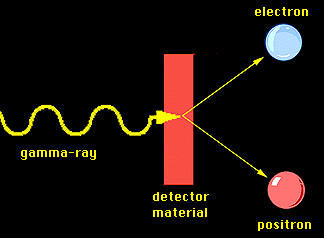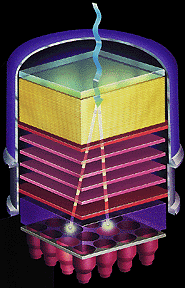 |
|
A view of the basic interaction in a pair production telescope. |
 |
|
A view of the basic interaction in a pair production telescope. |
With the advent of the large, sophisticated spark chambers such as COS-B and EGRET, high-energy gamma-ray astronomy has gone from being a discipline for instrumental specialists to being an integrated part of multiwavelength astronomy. At energies above 30 MeV, celestial objects such as pulsars, active galaxies, and diffuse emission are profitably studied with pair telescopes.
By reconstructing the tracks of the charged pair, the gamma-ray direction and therefore its origin on the sky are calculated. In addition, through the analysis of the scattering of the pair (which is an energy dependent phenomenon) or through the absorption of the pair by a scintillator detector after they exit the spark chamber, the total energy of the initial gamma-ray is determined.

It is very important to keep the chamber from triggering on the overwhelming flux of cosmic rays. To this end, anti-coincidence shields are used which cover the entire telescope with a charged particle detector. If the anti-coincidence shield has detected a charged particle, it won't allow the chamber to trigger to prevent detecting cosmic rays. In addition, it is common to have a so-called time-of-flight system, which are detectors which determine the relative times at which the pair travel through the chamber. In this way, it can be determined whether the pair came from the correct direction. The EGRET instrument, shown above, is the most successful pair telescope, containing all of the components discussed.

The energy resolution of spark chamber experiments is only about 20%. Losses in the chamber and the intrinsic resolution of the scintillator are relevant factors here. At the lowest energies, the resolution worsens since the pair particles lose energy through multiple scattering as they traverse the detector. These losses are difficult to account for. At high energies, the pair energy may be incompletely absorbed in the calorimeter, which can also limit energy resolution.
Related to larger collecting areas is the task of trying to expand the energy range over which the telescope is sensitive. At lower energies, one is limited to going down to about 20 MeV, which is the pair production threshold for most converter materials. Techniques which improve the sensitivity of telescopes from about 20 to 100 MeV, in order to merge with Compton Telescopes, are being researched. At the highest energies, larger collection areas will possibly allow space-based gamma-ray detectors to detect sources up to around 100 GeV, which will merge nicely with ground-based air Cerenkov detectors.
 |
|
The Gamma-ray Large Area Space Telescope (GLAST) |
New technologies are being explored for the next generation experiments. High on the list is the use of solid-state detectors as the tracking material instead of the gas filled chamber. This will allow for improved energy and spatial resolution. Improvements in energy resolution (perhaps 5% resolution) and spatial location (a few arcminutes for a single photon, a few arcseconds for a strong source) will make great contributions in understanding source behavior. In addition, a replenishable supply of chamber gas is no longer needed which will make longer mission lifetimes possible. The potential for future experiments is great since nearly 200 individual sources of high-energy gamma-rays have been detected with EGRET, and the possibility of thousands of sources is the goal of instrument designers.
Any Suggestions, mail to: emrah@astroa.physics.metu.edu.tr